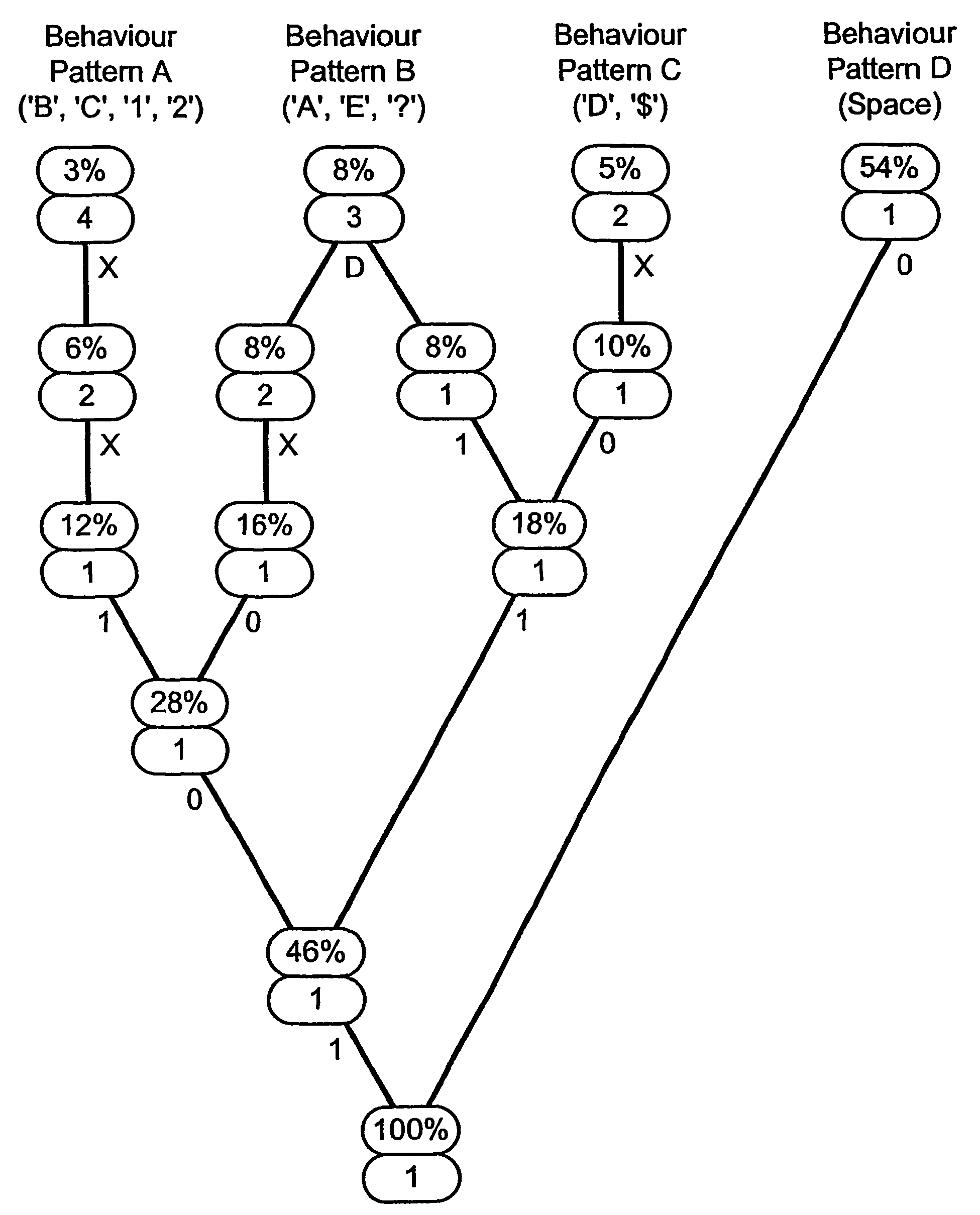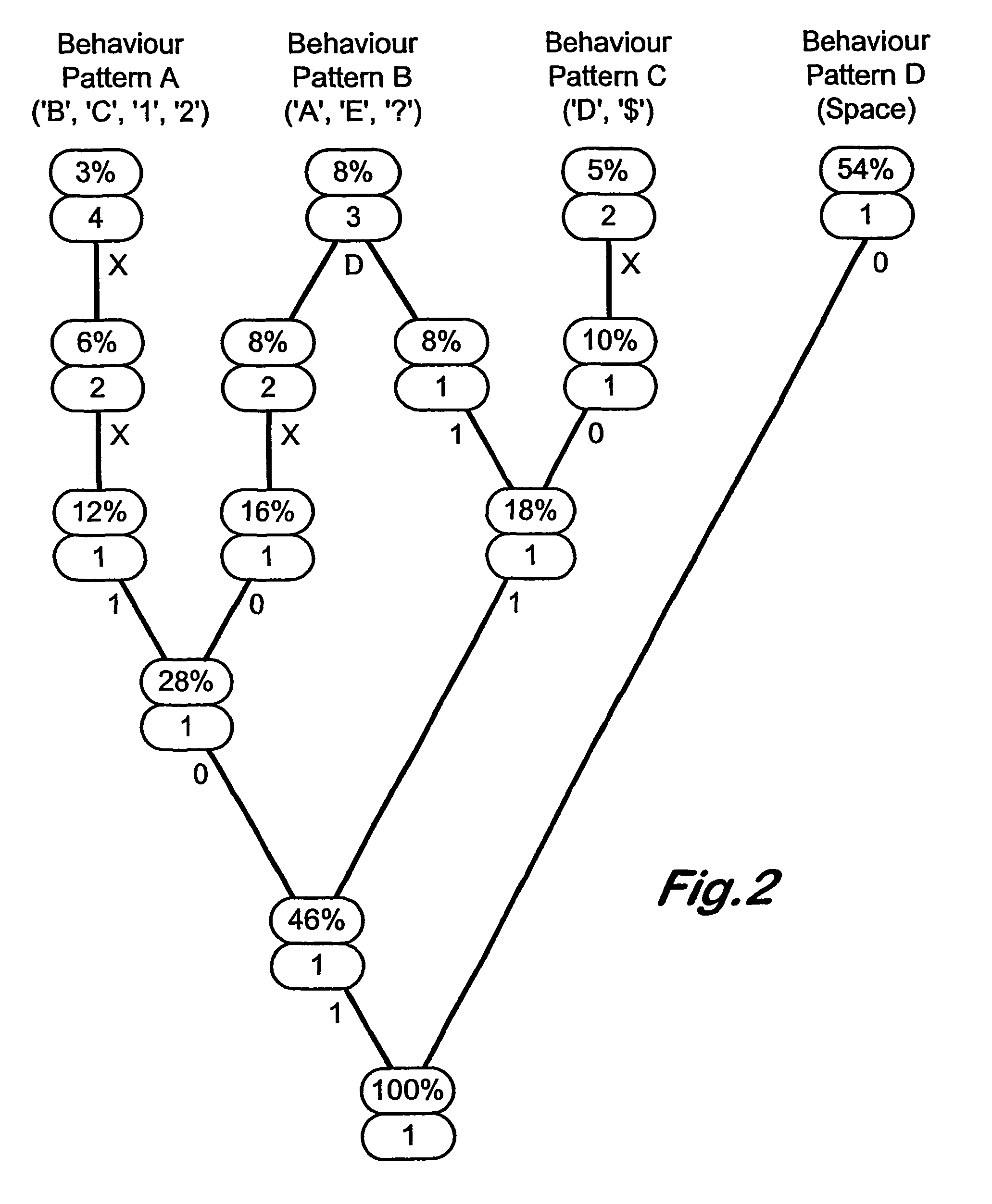Method of compressing data packets
a data packet and compression technology, applied in the field of data packet compression, can solve the problems of 75% of the total network capacity, inacceptable mobile network, and high cost of mobile phone environment, and achieve the effect of improving compression ratio, reducing memory requirements, and increasing the size of one character
- Summary
- Abstract
- Description
- Claims
- Application Information
AI Technical Summary
Benefits of technology
Problems solved by technology
Method used
Image
Examples
example 2
[0060]FIG. 3 shows an example and illustrates the invention and how its operational advantages arise. A header comprises 320 bits, and can be irregular, i.e. there are 2 to the power 320 possible headers. These are grouped into say 4 behaviour patterns: those which occur with probability A % (say containing 4 headers), those with B % (containing 4 headers) those which occur C % (say 10 headers) and those which occur D % (say this group is irregular and contains the remaining headers i.e. 2 to the power 320−18). The probabilities A to D are in decreasing order. The improved Huffman tree is constructed as in Figure. The group A is represented by a 1, the group B by 01 the group C by 001 and group D by 000. These are the first portion of the compressed headers and effectively are the Huffman codes for the groups. The second portion is the identifier which distinguishes the header from other headers in the same group. In the first group A there are 4 headers so one only needs a identifi...
example 3
[0064]In a simple example, of a preferred embodiment, one or more of the sub-units may be compressed according to the above described improved Huffman method. The compressed code for the complete header would comprise the cocatenated compressed codes for the sub-units and the sub-units themselves of any sub-unit which isn't compressed.
[0065]For example if a header comprises two sub-units, the first sub-unit comprising an address and the second sub-unit a random data string, the overall compressed header will comprise of the compressed address field cocatenated with the random data string.
[0066]Note that the fields in the compressed header do not have to occur in the same order as the fields in the uncompressed header.*
[0067]The table below shows a typical header; this may contain fields such as IP header, version number, header length, reserved flag, source address destination address, type of service. Each field has a number of different possible behaviours: e.g. the address field ...
example 4
[0070]A preferred, more complex embodiment will now be described. It is applicable to headers which have fields, wherein one or more field can have different types of behaviours. The first step for each field is to assign one or more different behaviour types. The next step is to determine, for each field, the probability that it will have a particular behaviour type, e.g. for each field determining the probability that it will be STATIC or INFERRED etc. This is shown in the last column of the table below.
[0071]In order to determine the number of different groups applied to the improved Huffman method, i.e. the number of different overall header behaviours, one multiplies out the number of different field behaviours for each field. In the example, a field behaviour is picked from field 1, a behaviour from field 2 and a behaviour from field 3. This is then repeated for each combination of field behaviours. This is shown in the second of the tables below. Additionally the probability ...
PUM
 Login to View More
Login to View More Abstract
Description
Claims
Application Information
 Login to View More
Login to View More - R&D
- Intellectual Property
- Life Sciences
- Materials
- Tech Scout
- Unparalleled Data Quality
- Higher Quality Content
- 60% Fewer Hallucinations
Browse by: Latest US Patents, China's latest patents, Technical Efficacy Thesaurus, Application Domain, Technology Topic, Popular Technical Reports.
© 2025 PatSnap. All rights reserved.Legal|Privacy policy|Modern Slavery Act Transparency Statement|Sitemap|About US| Contact US: help@patsnap.com



